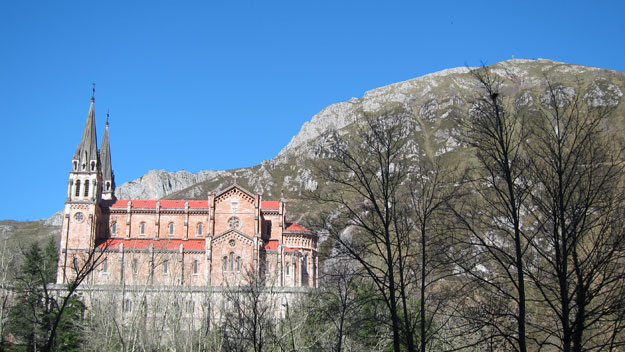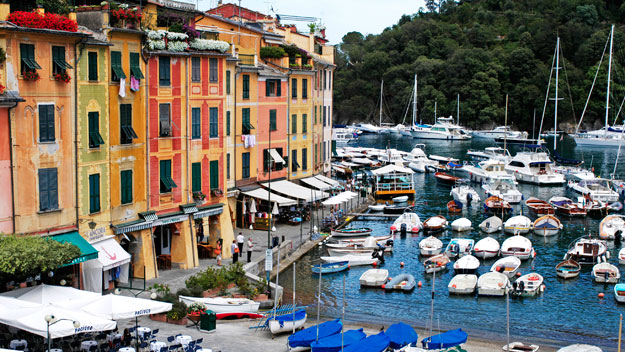It’s an ancient region, conservative, traditional and religious — one of the few places in Western Europe where it’s hard find people who speak English.
Rugged and mountainous with breathtaking scenery and a wild and beautiful coastline, dotted with stunning towns, Northern Spain should be at the top of every traveller’s wish list. Here are some of the region’s most sparkling gems:
San Sebastian
It’s blessed with great natural beauty, long sandy beaches and an annual influx of the world’s most famous and beautiful people, but San Sebastian — or Donostia is the local tongue — is all about one thing: food.
In just a few years the Basque city has become the gastronomic capital of the world, boasting the highest concentration of Michelin stars anywhere on the globe.
But you don’t need to book months in advance and fork out a small fortune to dine like a king in San Sebastian. The city is equally famous for its “pintxos” bars, which serve bite-sized local delicacies that make Southern Spain’s tapas seem bland and flavourless.
The Old Town is studded with these old-fashioned bars, which are usually crammed with old gentlemen, drinking and chatting as only European men can. Choose one, order a drink (it has to be the local sidra, a natural apple cider carbonated by pouring from a great height) and ask for a plate. You can sample as many pintxos as you please. When your drink is finished, simply tell the barman how many plates you’ve had, pay, and move on to the next bar.
Whole days in San Sebastian can be passed very pleasantly in this manner, with a break in the afternoon for the obligatory Spanish siesta.
The overall quality of pintxos bars in San Sebastian is excellent, but make sure you try these:
Martinez, Calle 31 de agosto (try the artichoke and jamon bombes. They don’t look too appetising but they are incredible)
Atari, Calle Mayor (order the beef cheek at the bar. It is amazing)
Gandarias, Calle 31 de agosto (steak is the specialty here. Order the green pepper variety at the bar)
Txuleta, Plaza Trinidad
La Cepa, Calle 31 de agosto (order the chargrilled padron paquillos at the bar. These tiny peppers are sweet and salty but one in 10 is blow-your-head-off hot)
Ganbara, Calle San Jeronimo
A San Sebastian bartender pouring the local specialty sidra.

An array of pintxos on offer at a San Sebastian bar.

When you’re too full to eat any more, walk off your lunch with a stroll along the boardwalk of La Concha Bay. Follow the city’s famous white wrought iron fence to the opposite end of the harbour, where the stunning Combs of the Winds sculptures sit.
Designed by local artist Eduardo Chillida, the giant twisted metal forms jut out from the rocks, battered by the often stormy seas. It’s a beautiful place, well worth the walk.
Close by, you can get the funicular to an amusement park atop the hill, which offers a stunning view of the whole city.
San Sebastian’s famous Combs of the Winds.

Santiago de Compostela
For more than 1200 years, pilgrims from all over Europe have made their way to Santiago de Compostela to pay their respects to the remains of Saint James, one of the fabled 12 apostles.
Legend has it that Saint James is buried under the city and from the 9th century, millions of Catholics have walked from their homes across Europe to Santiago de Compestela.
It’s an old tradition that hasn’t died out. In 2012, more than 200,000 people walk the Way of St James, the camino, every year, and many thousands more did without registering. Summer or winter, the streets of Santiago de Compestela are dotted with weary pilgrims staggering towards the great cathedral.
Make sure you visit the beautiful church and the surrounding Old Town, which was declared a UNESCO World Heritage site in 1985.
There are lovely artisanal shops and dozens of excellent restaurants, especially along Rua do Franco, and the night life is excellent.
For shopping, head across the road to the new town, which has all the big Spanish and international stores.
The famous cathedral at Santiago de Compostela.

Cangas de Onis
In the heart of the Asturias province and at the foothills of the Picos de Europa mountain range is the stunning town of Cangas de Onis.
The main attraction is the Roman bridge, which was built in the 1200s.
This is the town to buy artisanal products: local specialties from anchovies and sidra to chocolate and sweets are for sale in an array of attractive traditional shops.
There are numerous cheap and authentic restaurants perfect for lunch and the surrounding countryside is rugged and picturesque.
The Roman bridge at Cangas de Onis.

Covadonga
Venture higher into the Picos de Europas to this incredibly holy place. The cathedral sits atop a rocky outcrop and is absolutely beautiful.
Nearby is the shrine to Pelayo, who achieved the first Christian victory over the invading Islamic Moors in 722.
Spaniards, particularly Asturians, are extremely proud of this victory, making Covadonga one of the most popular attractions for local tourism.
Visiting the shrine is like a scene from anIndiana Jonesfilm. You walk down dark stairs hewn from solid rock into the side of the mountain, emerging in a tiny stone chapel hidden by a huge natural waterfall. It’s very beautiful and peaceful.
The beautiful mountain-top cathedral at Covadonga.

Santillana del Mar
Frequently declared the most beautiful village in Spain, Santillana del Mar is all cobblestone streets and old-fashioned charm.
It offers a glimpse into the lives of small town people who have lived more or less the same way for centuries.
Make sure you have a cup of coffee in one of the old grand hotels and don’t miss great local products for sale from small vendors.
Fun fact: Locals call Santillana del Mar the town that lies three times, since it is neither a Saint (Santo), nor flat (llana) and is nowhere near the sea (Mar).
Snow-capped mountains can be seen behind the beautiful town of Santillana del Mar.

Oviedo
For a city few people have heard of (soccer fans excepted), Oviedo has three huge claims to fame. Firstly, it has been repeatedly voted the cleanest town in Europe and it’s something its citizens take extremely seriously. There is no litter in the whole city. Anywhere. Ever.
There streets are also free from the stinking piles of household rubbish bags that mar countless European cities and this is no accident. Oviedo has some of the strictest rubbish laws in the world. Bags can only be put outside homes between 8pm and 10pm. Anything left on the street outside these hours is traced to its owner, who is then fined 3000 Euros.
The second of Oviedo’s trio of bragging points is San Julian de los Prados, a pre-Romanesque church that dates back to the 9th century. The church’s interior is decorated with some of the oldest frescoes in the world, which were recognised as a UNESCO World Heritage site in 1998.
The third, and most religiously significant, highlight of the city is the Sudarium of Oviedo, a religious relic that attracts hundreds of thousands of visitors a year to its home in the Cathedral of San Salvador.
The Vatican claims the Sudarium is the cloth that covered the face of Jesus as he was carried from the cross to his tomb. Science is not so sure, but has conceded the item is old enough to have performed the task.
The delicate piece of tissue is only displayed three days a year, Good Friday, the Feast of the Triumph of the Cross on September 14, and the feast’s conclusion on September 21. The rest of the time it is stored in darkness.
Old and new: The Guggenheim in Bilbao and the pre-Romanesque church in Oviedo.

Bilbao
When the Solomon R Guggenheim Foundation announced it would be building a Guggenheim museum in the port town of Bilbao in 1991, the world was surprised but Spaniards were shocked.
Bilbao was heavily industrialised and considered the dirtiest, ugliest town in Northern Spain. The museum changed everything, sparking a massive period of urban renewal resulting in the stylish modern town proudly on show today.
The Guggenheim museum, designed by Frank Gehry, is the gem of the town. Its striking modern architecture makes it just as much of a work of art as the priceless pieces it houses.
Walk around the outside and take it in before heading indoors. You need about two hours to explore the museum. Don’t miss the gift shop and the café on the top floor is excellent.
Afterwards, wander past the city’s famous giant dog crafted entirely from flowers and into the old town where excellent shopping can be found.
See it in style
Insight Vacations’ Northern Spain tour visits all of these destinations and many more, including Madrid and Barcelona.
The 11-day tour, which starts from $2535 per person, includes accommodation in premium city centre hotels, daily buffet breakfasts, hotel and restaurant dinners, the service of an expert tour director and local guides and a mix of included sightseeing and free time.
You’ll be escorted in a luxury coach, which has had 12 seats removed to give the remaining 40 chairs business class-style leg room, more window space to take in the views and smaller groups. There is also a toilet onboard.
“Travelling can be stressful. We can take that stress away, taking care of all the hassles and details so all you have to do is show up and have the time of your life,” Insight Vacations CEO John Boulding says.
“Our motto is, ‘Experience the Art of Touring in Style’ and that’s what we’re all about: style. It’s not the cheapest, but it’s the best.”


